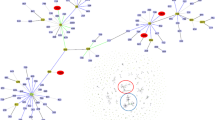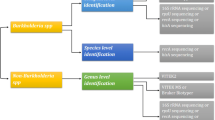Abstract
The Burkholderia cepacia complex (Bcc) organisms remain significant pathogens in patients with cystic fibrosis (CF). This study was performed to evaluate the prevalence, epidemiological characteristics, and presence of molecular markers associated with virulence and transmissibility of the Bcc strains in the National CF Centre in Belgrade, Serbia. The Bcc isolates collected during the four-year study period (2010–2013) were further examined by 16 s rRNA gene, pulsed-field gel electrophoresis of genomic DNA, multilocus sequence typing analysis, and phylogenetic analysis based on concatenated sequence of seven alleles. Fifty out of 184 patients (27.2 %) were colonized with two Bcc species, B. cenocepacia (n = 49) and B. stabilis (n = 1). Thirty-four patients (18.5 %) had chronic colonization. Typing methods revealed a high level of similarity among Bcc isolates, indicating a person-to-person transmission or acquisition from a common source. New sequence types (STs) were identified, and none of the STs with an international distribution were found. One centre-specific ST, B. cenocepacia ST856, was highly dominant and shared by 48/50 (96 %) patients colonized by Bcc. This clone was characterized by PCR positivity for both the B. cepacia epidemic strain marker and cable pilin, and showed close genetic relatedness to the epidemic strain CZ1 (ST32). These results indicate that the impact of Bcc on airway colonization in the Serbian CF population is high and virtually exclusively limited to a single clone of B. cenocepacia. The presence of a highly transmissible clone and probable patient-to-patient spread was observed.


Similar content being viewed by others
References
Hauser AR, Jain M, Bar-Meir M, McColley SA (2011) Clinical significance of microbial infection and adaptation in cystic fibrosis. Clin Microbiol Rev 24:29–70. doi:10.1128/CMR.00036-10
Isles A, Maclusky I, Corey M, Gold R, Prober C, Fleming P, Levison H (1984) Pseudomonas cepacia infection in cystic fibrosis: an emerging problem. J Pediatr 104:206–210. doi:10.1016/S0022-3476(84)80993-2
Ledson MJ, Gallagher MJ, Jackson M, Hart CA, Walshaw MJ (2002) Outcome of Burkholderia cepacia colonisation in an adult cystic fibrosis centre. Thorax 57:142–145. doi:10.1136/thorax.57.2.142
Saiman L, Siegel JD, LiPuma JJ, Brown RF, Bryson EA, Chambers MJ et al (2014) Infection prevention and control guideline for cystic fibrosis: 2013 update. Infect Control Hosp Epidemiol 35(Suppl 1):S1–S67. doi:10.1086/676882
Baldwin A, Mahenthiralingam E, Drevinek P, Vandamme P, Govan JR, Waine DJ, LiPuma JJ, Chiarini L, Dalmastri C, Henry DA, Speert DP, Honeybourne D, Maiden MC, Dowson CG (2007) Environmental Burkholderia cepacia complex isolates in human infections. Emerg Infect Dis 13:458–461. doi:10.3201/eid1303.060403
Kim JM, Ahn Y, LiPuma JJ, Hussong D, Cerniglia CE (2015) Survival and susceptibility of Burkholderia cepacia complex in chlorhexidine gluconate and benzalkonium chloride. J Ind Microbiol Biotechnol 42:905–913. doi:10.1007/s10295-015-1605-x
Drevinek P, Vosahlikova S, Cinek O, Vavrova V, Bartosova J, Pohunek P, Mahenthiralingam E (2005) Widespread clone of Burkholderia cenocepacia in cystic fibrosis patients in the Czech Republic. J Med Microbiol 54:655–659. doi:10.1099/jmm.0.46025-0
France MW, Dodd ME, Govan JR, Doherty CJ, Webb AK, Jones AM (2008) The changing epidemiology of Burkholderia species infection at an adult cystic fibrosis centre. J Cyst Fibros 7:368–372. doi:10.1016/j.jcf.2008.01.002
LiPuma JJ (2010) The changing microbial epidemiology in cystic fibrosis. Clin Microbiol Rev 23:299–323. doi:10.1128/CMR.00068-09
Drevinek P, Mahenthiralingam E (2010) Burkholderia cenocepacia in cystic fibrosis: epidemiology and molecular mechanisms of virulence. Clin Microbiol Infect 16:821–830. doi:10.1111/j.1469-0691.2010.03237.x
Govan JR, Brown AR, Jones AM (2007) Evolving epidemiology of Pseudomonas aeruginosa and the Burkholderia cepacia complex in cystic fibrosis lung infection. Future Microbiol 2:153–164. doi:10.2217/17460913.2.2.153
Zolin A, McKone EF, van Rens J et al (2014) ECFSPR Annual Report 2010
CFF (2014) Cystic fibrosis foundation patient registry 2013 annual data report. Bethesda, Maryland: Cystic Fibrosis Foundation
CFF (2015) The Canadian cystic fibrosis registry 2013 annual report. Toronto, Ontario: Cystic Fibrosis Canada
Radivojevic D, Sovtic A, Minic P, Grkovic S, Guc-Scekic M, Lalic T, Miskovic M (2013) Newborn screening for cystic fibrosis in Serbia: a pilot study. Pediatr Int 55:181–184. doi:10.1111/ped.12009
Heath DG, Hohneker K, Carriker C, Smith K, Routh J, LiPuma JJ, Aris RM, Weberand D, Gilligan PH (2002) Six-year molecular analysis of Burkholderia cepacia complex isolates among cystic fibrosis patients at a referral center for lung transplantation. J Clin Microbiol 40:1188–1193. doi:10.1128/JCM.40.4.1188-1193.2002
Tenover FC, Arbeit RD, Goering RV, Mickelsen PA, Murray BE, Persing DH, Swaminathan B (1995) Interpreting chromosomal DNA restriction patterns produced by pulsed-field gel electrophoresis: criteria for bacterial strain typing. J Clin Microbiol 33:2233–2239
Jovcic B, Begovic J, Lozo J, Topisirovic L, Kojic M (2009) Dynamic of sodium dodecyl sulfate utilization and antibiotic susceptibility of strain Pseudomonas sp. ATCC19151. Arch Biol Sci 61:159–165. doi:10.2298/ABS0902159J
Tamura K, Stecher G, Peterson D, Filipski A, Kumar S (2013) MEGA6: molecular evolutionary genetics analysis version 6.0. Mol Biol Evol 30:2725–2729. doi:10.1093/molbev/mst197
Spilker T, Baldwin A, Bumford A, Dowson CG, Mahenthiralingam E, LiPuma JJ (2009) Expanded multilocus sequence typing for Burkholderia species. J Clin Microbiol 47:2607–2610. doi:10.1128/JCM.00770-09
Jolley KA, Maiden MC (2010) BIGSdb: scalable analysis of bacterial genome variation at the population level. BMC Bioinformatics 11:595. doi:10.1186/1471-2105-11-595
Dedeckova K, Kalferstova L, Strnad H, Vavrova J, Drevinek P (2013) Novel diagnostic PCR assay for Burkholderia cenocepacia epidemic strain ST32 and its utility in monitoring infection in cystic fibrosis patients. J Cyst Fibros 12:475–481. doi:10.1016/j.jcf.2012.12.007
Graindorge A, Menard A, Neto M, Bouvet C, Miollan R, Gaillard S, de Montclos H, Laurent F, Cournoyer B (2010) Epidemiology and molecular characterization of a clone of Burkholderia cenocepacia responsible for nosocomial pulmonary tract infections in a French intensive care unit. Diagn Microbiol Infect Dis 66:29–40. doi:10.1016/j.diagmicrobio.2009.06.008
Clode FE, Kaufmann ME, Malnick H, Pitt TL (2000) Distribution of genes encoding putative transmissibility factors among epidemic and nonepidemic strains of Burkholderia cepacia from cystic fibrosis patients in the United Kingdom. J Clin Microbiol 38:1763–1766
Lee TW, Brownlee KG, Conway SP, Denton M, Littlewood JM (2003) Evaluation of a new definition for chronic Pseudomonas aeruginosa infection in cystic fibrosis patients. J Cyst Fibros 2:29–34. doi:10.1016/S1569-1993(02)00141-8
Nelson JW, Doherty CJ, Brown PH, Greening AP, Kaufmann ME, Govan JR (1991) Pseudomonas cepacia in inpatients with cystic fibrosis. Lancet 338:1525. doi:10.1016/0140-6736(91)92342-Y
Govan JRW (2006) Other gram-negative organisms. Burkholderia cepacia complex and Stenotrophomonas maltophilia. In: Bush A, Alton EWFW, Davies JC, Griesenbach U, Jaffe A (eds) Cystic fibrosis in the 21st Century, 1st edn. Karger, Basel, pp 145–152
Conway S, Balfour-Lynn IM, De Rijcke K, Drevinek P, Foweraker J, Havermans T, Heijerman H, Lannefors L, Lindblad A, Macek M, Madge S, Moran M, Morrison L, Morton A, Noordhoek J, Sands D, Vertommen A, Peckham D (2014) European cystic fibrosis society standards of care: framework for the cystic fibrosis centre. J Cyst Fibros 13(Suppl 1):S3–S22. doi:10.1016/j.jcf.2014.03.009
Agodi A, Mahenthiralingam E, Barchitta M, Gianninò V, Sciacca A, Stefani S (2001) Burkholderia cepacia complex infection in Italian patients with cystic fibrosis: prevalence, epidemiology, and genomovar status. J Clin Microbiol 39:2891–2896. doi:10.1128/JCM.39.8.2891-2896.2001
Slinger R, Yan L, Myers R, Ramotar K, St Denis M, Aaron SD (2007) Pyrosequencing™ of a recA gene variable region for Burkholderia cepacia complex genomovar identification. Diagn Microbiol Infect Dis 58:379–384. doi:10.1016/j.diagmicrobio.2007.02.011
Vandamme P, Dawyndt P (2011) Classification and identification of the Burkholderia cepacia complex: past, present and future. Syst Appl Microbiol 34:87–95. doi:10.1016/j.syapm.2010.10.002
Saiman L, Siegel J, Cystic Fibrosis Foundation (2003) Infection control recommendations for patients with cystic fibrosis: microbiology, important pathogens, and infection control practices to prevent patient-to-patient transmission. Infect Control Hosp Epidemiol 24(5 Suppl):S6–S52. doi:10.1086/503485
Nzula S, Vandamme P, Govan JR (2000) Sensitivity of the Burkholderia cepacia complex and Pseudomonas aeruginosa to transducing bacteriophages. FEMS Immunol Med Microbiol 28:307–312. doi:10.1111/j.1574-695X.2000.tb01491.x
Yang JH, Spilker T, LiPuma JJ (2006) Simultaneous coinfection by multiple strains during Burkholderia cepacia complex infection in cystic fibrosis. Diagn Microbiol Infect Dis 54:95–98. doi:10.1016/j.diagmicrobio.2005.08.020
Bernhardt SA, Spilker T, Coffey T, LiPuma JJ (2003) Burkholderia cepacia complex in cystic fibrosis: frequency of strain replacement during chronic infection. Clin Infect Dis 37:780–785. doi:10.1086/377541
Horsley A, Webb K, Bright-Thomas R, Govan J, Jones A (2011) Can early Burkholderia cepacia complex infection in cystic fibrosis be eradicated with antibiotic therapy? Front Cell Infect Microbiol. doi:10.3389/fcimb.2011.00018
Dedeckova K, Fila L, Skalicka V, Bartosova J, Kucerova T, Vavrova V, Zemkova D, Kalferstova L, Melter O, Cinek O, Drevinek P (2012) PCR detection of Burkholderia cepacia complex as one of key factors to handle a long-term outbreak. J Cyst Fibros 11:440–445. doi:10.1016/j.jcf.2012.04.005
Acknowledgments
This work was supported by grant No. 173019 from the Ministry of Education, Science and Technological Development of the Republic of Serbia.
Author information
Authors and Affiliations
Corresponding author
Ethics declarations
Conflict of interest
The authors declare that they have no conflict of interest.
Ethical approval
Ethical approval for this study was granted by the Ethics Committee of the School of Medicine, University of Belgrade (approval No. 29/V-10).
Patients were identified with a unique hospital number (code known by ZV), while the anonymity status of the patients to any third party was preserved and guaranteed during and after the study.
Rights and permissions
About this article
Cite this article
Vasiljevic, Z.V., Novovic, K., Kojic, M. et al. Burkholderia cepacia complex in Serbian patients with cystic fibrosis: prevalence and molecular epidemiology. Eur J Clin Microbiol Infect Dis 35, 1277–1284 (2016). https://doi.org/10.1007/s10096-016-2662-4
Received:
Accepted:
Published:
Issue Date:
DOI: https://doi.org/10.1007/s10096-016-2662-4




